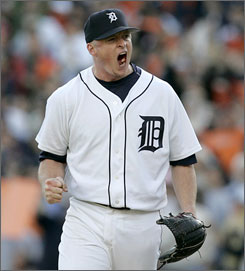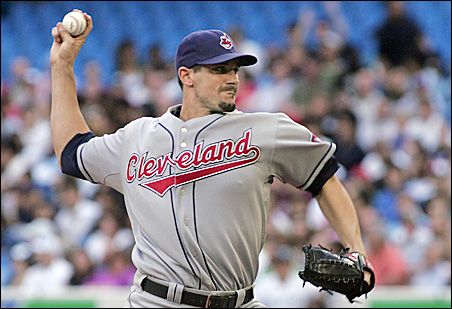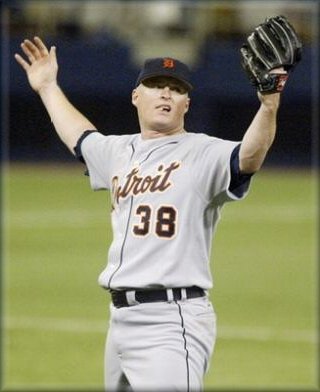 Indians Archive
Indians Archive  Can a Tiger Find His Stripes in Cleveland?
Can a Tiger Find His Stripes in Cleveland?

Since it seems as if the Bonderman-as-veteran-arm rumor seems to be gaining some steam, let’s make our first foray into the Hot Stove because…well, if your driveway looks anything like mine, you could use a little heat. Regardless of the facts that it’s February and that Pitchers and Catchers report in less than two weeks, this off-season has been so devoid of “news” or even “rumors” involving the Indians, let’s take the opportunity to rationalize what Bonderman (if added) represents as a player and what he would mean to the 2011 Tribe.
Is this jumping into thing a bit, since there have only been reports that the Indians are interested in seeking deal with Bonderman?
Maybe, but since I don’t know if I can write another comparison to teams of yesteryear or preach patience to see what these young players can do, let’s take the opportunity to pull up a stool to the Hot Stove…even if everyone else in MLB deserted their spots around the fire a couple of weeks/months ago.
Regardless, regarding Bonderman, a friend of mine e-mailed me to say that “if Bonderman isn’t the textbook Indians’ signing, I don’t know who is”, adding a snarky comment about Josh Tomlin to boot. But Bonderman certainly does fit the Indians’ profile of the past few years in terms of adding an undervalued veteran arm from the scrap heap and seeing if they can put some polish on someone else’s refuse.
In particular, Bonderman’s situation is interesting when you compare it to the last “bargain-bin” shopping purchase that the Indians found for their rotation, with some eerie similarities to Hot Carl Pavano and the career arc for each. To start off this little comparison, realize that the ages are going to be different and the timeframes and leagues are not going to allow a true “apples-to-apples” look, but you’ll see that Bonderman over the last 5 years and Pavano, from his time in Florida to Minnesota, actually represent some interesting comps, starting with Bonderman’s best season…way back in 2006:
Jeremy Bonderman – 2006 (Age 23)
4.08 ERA (112 ERA+), 1.30 WHIP, 8.5 K/9, 2.7 BB/9, 3.16 K/BB in 214 IP over 34 games
After that 2006 season, the then-23-year-old Bonderman signed a 4-year deal with the Motor City Kitties that paid him $38M through the end of 2010. Prior to the 2007 season, Baseball Prospectus wrote that, “Bonderman is as good a bet as any pitcher in the American League to win a Cy Young Award, provided that Johan Santana gets hit by a bus or something.”
Seriously…
Carl Pavano – 2004 (Age 28)
3.00 ERA (137 ERA+), 1.17 WHIP, 5.6 K/9, 2.0 BB/9, 2.84 K/BB in 222 1/3 IP over 31 games
Certainly, Pavano’s 2004 makes Bonderman’s 2006 pale in comparison (and how crazy is it to see what Pavano did back in 2004), but just like Bonderman, Pavano parlayed this season into a 4-year deal with the Evil Empire worth $39.95M, nearly identical to the deal Bonderman signed after his 2006 season, with the $1.95M difference being the buy-out of Pavano’s 2009 option.
We all know what happened in the Big Apple in the ensuing years with the “American Idle”, so let’s not re-hash that again. Just realize, for the purposes of attempting to find apples-too apples, Pavano missed the entire 2006 season with an injury, so his 4-year total is being used in comparison to Bonderman’s 3-year total, a period during which Bonderman struggled to stay in the rotation consistently for the first 3 years of the deal, posting this line in that three-year stretch:
Jeremy Bonderman – 2007 to 2009
4.96 ERA (92 ERA+), 1.47 WHIP, 6.8 K/9, 3.2 BB/9, 2.11 K/BB in 256 IP over 48 games
In this timeframe, Bonderman battled multiple injuries, including a sore elbow that caused his disappointing 2007 and a very serious shoulder clot in 2008. Unquestionably ugly and a significant drop-off from his 2006, but compare those numbers to Pavano’s as a Yankee:
Carl Pavano – 2005 to 2008
5.00 ERA (87 ERA+), 1.46 WHIP, 4.6 K/9, 1.9 BB/9, 2.5 K/BB in 145 2/3 IP over 26 games
After posting that three-year cumulative line, Pavano made his way out of New York and onto the North Coast, drawing howls of despair (from me, admittedly...among others) as nobody could figure out why the Indians were willing to guarantee THIS pitcher even $1.5M prior to the 2009 season. That’s where the Indians come in and pick Pavano up, dust him off, and put some shine back on his apple. However, we’re still in the timeline of trying to figure out where Bonderman would fit in terms of re-establishing himself, as Pavano did in 2010.
That’s where the Indians come in and pick Pavano up, dust him off, and put some shine back on his apple. However, we’re still in the timeline of trying to figure out where Bonderman would fit in terms of re-establishing himself, as Pavano did in 2010.
Thus, entering last year, still on the road to recovery, Bonderman returned to the Tigers’ rotation for 2010 producing this line:
Jeremy Bonderman – 2010 (Age 27)
5.53 ERA (76 ERA+), 1.44 WHIP, 5.9 K/9, 3.2 BB/9, 1.87 K/BB in 171 IP over 30 games
Nothing to write home about for sure but interestingly, Bonderman experienced some success to start the season (he had a 4.06 ERA in mid-June through 12 starts and a 4.36 ERA at the beginning of July through 14 starts) until falling apart as the season wore on, posting a 6.68 ERA through his final 17 starts to ugly up his overall 2010 line.
That out there, how about comparing what Bonderman did in 2010 to the numbers that Pavano put up in 2009 as a member of the Indians and the Twins:
Carl Pavano – 2009 (Age 33)
5.10 ERA (84 ERA+), 1.38 WHIP, 6.6 K/9, 1.8 BB/9, 3.77 K/BB in 199 1/3 IP over 33 games
Avert your gaze upward again and look at Bonderman from 2010 while you realize that this 2009 line from Pavano turned out to be what he used to re-establish himself (somewhat) in MLB in 2009, leading to a $7M payday from Minnesota for the 2010 season. Obviously, there’s a big difference in the BB/9 from Pavano in 2009 to Bonderman in 2010, but the ERA and the WHIP aren’t really that far off and while the advanced metrics (FIP, xFIP, SIERA) certainly favor Pavano in this comparison, it is worth noting that Pavano used this season as a jumping point for his 3.75 ERA in Minnesota this past year.
Certainly, I’m not here to suggest that Bonderman is going to be posting a 3.75 ERA for the Indians in 2011, only that the Indians were able to identify Pavano as a player who could be had on the cheap who was due for a rebound season. If we’re talking about the same Front Office and analysts having a hand in this decision, doesn’t it stand to reason that they surveyed what was available on the “third tier” market (and I’ll explain that term that I’ve used before) and decided that Bonderman was the one that they wanted to target?
What makes them think that?
Who’s to say, but it is worth noting that (with their possible attempted exploitation of the undervalued groundball pitcher) both Bonderman and Pavano had similar GB% in those last two years that I compared - Bonderman 2010: 44.7%, Pavano 2009: 43.2%) - and it stands to reason that the GB tendencies of Bonderman could have played a role. It is worth noting that Pavano bumped that GB% up to 51.2% last year, but also that Bonderman’s career GB% is 46.5% and Pavano’s is 46%. That may just be a coincidence and the loss in velocity on Bonderman’s fastball is disconcerting (his average fastball was 93.3 MPH in 2006 and averaged 89.8 MPH in 2010), but if the Indians are looking to add a veteran arm that essentially allows them to slot the young arms who SHOULD be depth starters (Gomez, Tomlin, Huff, etc.) to start the season, why not Bonderman, for whom Bill James’ projections peg for a 4.58 ERA (James’ projections have Talbot at a 4.73 ERA), to eat some innings.
That may just be a coincidence and the loss in velocity on Bonderman’s fastball is disconcerting (his average fastball was 93.3 MPH in 2006 and averaged 89.8 MPH in 2010), but if the Indians are looking to add a veteran arm that essentially allows them to slot the young arms who SHOULD be depth starters (Gomez, Tomlin, Huff, etc.) to start the season, why not Bonderman, for whom Bill James’ projections peg for a 4.58 ERA (James’ projections have Talbot at a 4.73 ERA), to eat some innings.
The question needs to be asked whether they need a guy like Bonderman, to eat innings, if 2011 is all about answering questions about the in-house talent and the difference for me lies in the fact that the assumed 5th starter candidates (without Bonderman) all look like 5th starters/AAAA fodder at this point in their career, with nothing they did in 2010 doing anything to change that perception.
With that in mind, I’d assert that the logic that was espoused in this space back in October still holds firm:
I’m not overly convinced that the likes of Talbot, Tomlin, Gomez, and Huff are much more than “Cleveland to Columbus” fodder and past Carmona, Carrasco, and Masterson (who, frankly, still could end up in the bullpen), the next group of arms is a fair distance away from legitimately contributing. To that end, Alex White excites me and Corey Kluber, Zach McCallister, and Yohan Pino intrigue me at some level (and in that order), but I don’t think that those guys are going to be ready when the season starts to be in Cleveland, just like I don’t think that Tomlin or Gomez should join Huff in some sort of less-than-compelling “competition” for the 5th spot.
Certainly the team needs to separate the wheat from the chaff, but I would allow some of that to continue to happen on the AAA level and see if the team could add an arm (or two) to that mix of the parent club to push guys like Tomlin, Gomez, Huff, and the group below them into a position where they’re forcing THEMSELVES into an opportunity instead of an opportunity being forced upon them, perhaps prematurely. Certainly, the Indians need to find what they have in their back-end-of-the-rotation grab-bag, but given that all of those guys have options (save Talbot), I’d utilize those options and add some legitimate depth in the rotation for next year. If Tomlin/Gomez/Huff or White/Kluber/McCallister/Pino force themselves into the conversation – terrific, but putting them squarely in the conversation when they may not necessarily belong there is what frightens me.
If Bonderman is able to allow them some time to allow those guys in AAA to sort themselves out and slot themselves for when a starter is needed (and a starter WILL be needed at some point…whether it’s to replace Bonderman or someone else), than Bonderman is the lottery ticket that the Indians just bought at the corner store.
Why Bonderman over the rest of the “third tier” arms?
Just as relevant to the conversation here is something that was written last November, when an off-season road-map (one that never made it out of the glove compartment apparently) was laid out and Bonderman was mentioned as a possible fit. In laying out particular pitchers that could be fits for the 2010 Indians, I wrote that the Indians were likely to be selecting from a “third-tier of FA pitcher – the scratch and dent section...included in this tier are the likes of Bruce Chen, Brandon Webb, Javier Vazquez, Chris Young, Ben Sheets, Justin Duchscherer, Jeremy Bonderman, all of whom come with injury or performance concerns and all who are likely to be available on a shorter, incentive-laden deal...but with good reason.”
Interestingly, we can now go back and look at the deals that most of these guys received (and, in full disclosure, I was hoping for Webb...although his velocity could be lower than Bonderman), and realize that all of those guys were likely on the Indians’ radar at some point with the decision to (perhaps) add Bonderman being affected by other teams’ offers, but also the Indians own preferences for the veteran arm that they would add.
Most of the names mentioned above signed incentive-laden deals and the Indians set the current industry standard for how to work one of these “scrap-heap signings” to their benefit in the case of Pavano. If you’ll remember, Pavano’s deal was for $1.5M base salary with $5.3M in performance bonuses that escalated with each start over 18 and every inning pitched past 130.
If the Indians add Bonderman, it’s likely that they’ll include similar incentives and hope to find the same success that they did just two years ago when they “inexplicably” added Pavano prior to the 2009 season. At that time, the Pavano signing was ridiculed, with the performance of Pavano since that time justifying the risk (low as it may have been) taken on Hot Carl and earning the benefit of the doubt (to a degree) for the veteran arm that is likely to join the ranks in Goodyear this Spring.
In a perfect world, would it be idea for the Indians to add more than Bonderman?
Of course, but within the realities of MLB, if the Indians add Bonderman, they assume little risk and likely buy themselves some time to learn more about their arms on the farm. With the current group of 5th starter candidates underwhelming and the layer beneath them (most notably Al White, but also Kluber and McAllister, among others) looking like they’ll need some time in AAA (like Gomez and Tomlin may as well), Bonderman would look to have a leg up and perhaps offers the Indians an arm to eat innings and buy time until some longer-term answers arrive from the farm as the Indians’ Front Office looks to catch lightning in a bottle one more time in the starting rotation.
- NBA Announces 2013-2014 Schedule
- Browns Ink Sharknado
- Sharknado A No-Show For Rookie Camp
- Trent Richardson Out Until Training Camp
- Browns Sign Brandon Jackson
- Carrasco Suspended Eight Games
- Browns Add to Wide Receiver Depth with David Nelson
- Browns Need to Learn from Past Draft Mistakes
- Browns Release Chris Gocong and Usama Young
- Browns Missing on Grimes Disappointing, But Not The End
The TCF Forums
- Chris Grant's first 3 drafts
Kingpin74 (Tuesday, January 21 2014 10:13 AM) - The 2014 Offseason Thread
googleeph2 (Tuesday, January 21 2014 9:36 AM) - 2015 Recruiting
furls (Tuesday, January 21 2014 6:57 AM) - Mike Brown
YahooFanChicago (Monday, January 20 2014 11:15 PM) - Movies coming out
HoodooMan (Monday, January 20 2014 9:34 PM) - 2014 Hoops Hockey Hijinx
jpd1224 (Monday, January 20 2014 4:44 PM) - 2014 Recruiting
jclvd_23 (Monday, January 20 2014 2:26 PM) - Wish List - #4 Pick
Hikohadon (Monday, January 20 2014 1:26 PM) - Official- Browns Coach Search/Rumors
OldDawg (Sunday, January 19 2014 6:48 PM) - #1 overall pick Anthony Bennett
TouchEmAllTime (Sunday, January 19 2014 1:28 PM)


